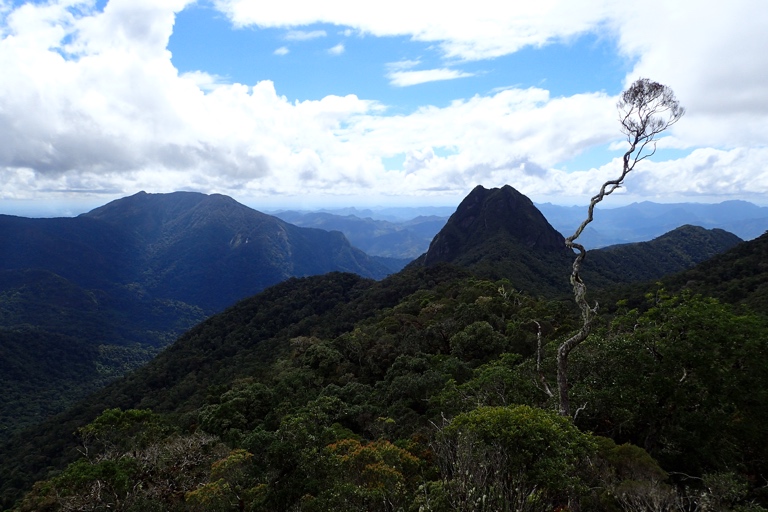- From the forests of Marojejy National Park in Madagascar, researchers have described a new species of leaf-tailed gecko that has a somewhat compressed body, a small triangular head, and a leaf-shaped tail.
- So far, the gecko, named Uroplatus finaritra, is known only from within a small area at lower altitudes in Marojejy. Since forests in this area are rapidly disappearing due to illegal logging activity, both in and around the park, the researchers recommend that the gecko be listed as endangered on the IUCN Red List.
- The gecko may also have already appeared in the international pet trade under the label of the more common satanic leaf-tailed gecko, Uroplatus phantasticus.
A leaf-tailed gecko can be incredibly tricky to find. These lizards in the genus Uroplatus, found only in the forests of Madagascar, can masterfully camouflage themselves among dried leaves, sometimes with a foot that sticks out, resembling a twig. “One is, effectively, searching for a leaf in a maelstrom of leaves,” Mark D. Scherz, a Ph.D. student at Ludwig Maximilian University of Munich in Germany, told Mongabay.
But researchers surveying Marojejy National Park in northeastern Madagascar have just described a new species of leaf-tailed gecko — one that may already be threatened with extinction because of habitat loss and the illegal pet trade.
The new species, named Uroplatus finaritra and described in a study published in Zootaxa, is known locally as tahafisaka, according to lead author Fanomezana Ratsoavina, a herpetologist at the University of Antananarivo in Madagascar. “Local guides know about the existence of this leaf-tailed gecko, but they do not know about this recent change in the taxonomy,” Ratsoavina said. “Marojejy is one of the most visited national parks by tourists and this gecko is appreciated by visitors for its stunning look.”

Ratsoavina first came across U. finaritra back in 2003, when she was conducting her first field study in Marojejy as part of her master’s degree. But at the time, she didn’t know the gecko was new to science.
Several years later, in May 2016, Achille Raselimanana, another herpetologist from the University of Antananarivo, collected specimens of the gecko from Marojejy, suspecting that it was a new species. “Although it quite closely resembles a similar species, the ‘satanic leaf-tailed gecko,’ Uroplatus phantasticus, it seemed new because the body size is considerably larger than that species,” Scherz, a co-author on the paper, told Mongabay in an email. “I returned as part of Prof. Miguel Vences’ team in November of 2016, and was fortunate enough to find two further individuals, both at considerable heights above the ground.”
The researchers then took the specimens back to the lab, and by analyzing the gecko’s DNA, confirmed that the species was indeed new to science.
Like other leaf-tailed geckos, U. finaritra, too, has a somewhat compressed body, a small triangular head, and a leaf-shaped tail. But the most distinctive feature of the new species is its size, the researchers say. While U. finaritra belongs to a group of small-sized leaf-tailed geckos, it’s a giant within this group. The inside of U. finaritra’s mouth is also dark red in color, Scherz said, which sets it apart from its relatives like the satanic leaf-tailed gecko whose mouth is black on the inside.
The researchers named the new species after the Malagasy word finaritra, meaning “healthy and happy,” in reference to their “delight in describing this splendid and exceptionally large species from a clade of generally small-sized leaf-tailed geckos.”
The new species, however, may already be threatened with extinction. At present, the gecko is known only from a small area in the lower altitudes of Marojejy National Park. Since forests in this area are rapidly disappearing due to illegal logging activity, both in and around Marojejy, the researchers have recommended that the gecko be listed as endangered on the IUCN Red List.

Case of mistaken identity
It’s not just habitat loss that threatens the new species. The gecko may also already be a victim of the illegal pet trade, the researchers say. The satanic leaf-tailed gecko is a popular pet worldwide, and the researchers think that U. finaritra may have already appeared in the international pet trade under the name Uroplatus phantasticus “giant” (or a larger-sized satanic leaf-tailed gecko), listed at higher prices than the “normal” U. phantasticus.
“A young individual of U. finaritra can only be distinguished from U. phantasticus adults by checking the color of its mouth,” Scherz said. “This is not an easy thing to do, requires stress to the animals, and could potentially hurt them irreparably if performed forcefully by a non-expert.”
One way to reduce the risk of the new species being mistakenly traded as the more common satanic leaf-tailed gecko is to include information of the geckos’ precise geographic origin, the researchers say. Based on current knowledge, for example, the new species is thought to occur north of the range of the satanic leaf-tailed gecko within Madagascar’s Sava region. So any gecko that shows up as “U. phantasticus Sava region” for export could immediately be flagged as a likely misidentified U. finaritra, Scherz said.
Ratsoavina said the practice of threatened species being traded under the guise of more common species remains a big problem in Madagascar’s pet trade.
“While discovering a new species is very exciting, we also need to think about its conservation,” she said. “If the natural population of Uroplatus finaritra from Marojejy National Park stays intact without further habitat loss and illegal exploitation activities to supply the pet trade, this species will remain safe.”

Citation:
Ratsoavina, F. M. et al. (2019). Finaritra! A splendid new leaf-tailed gecko (Uroplatus) species from Marojejy National Park in north-eastern Madagascar. Zootaxa. DOI: http://dx.doi.org/10.11646/zootaxa.4545.4.7